#crown beard
Photo
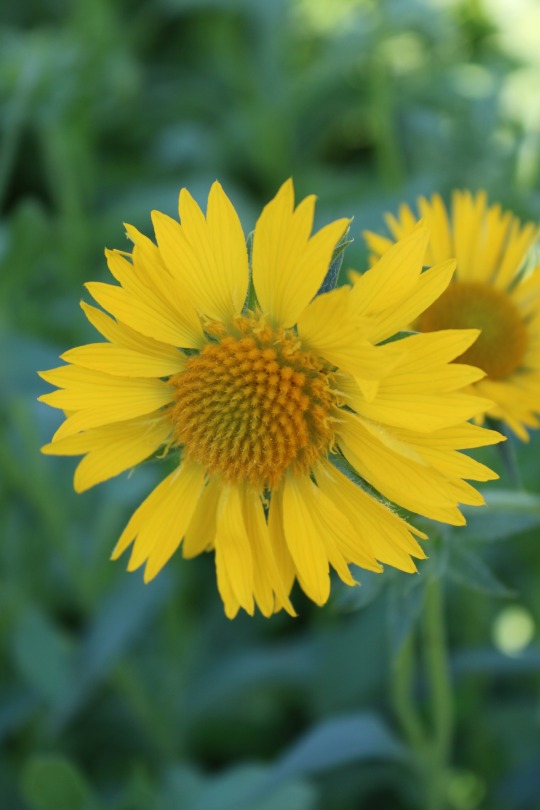
Golden Crownbeard (Verbesina Encelloides)
Toulouse, France
#photographers on tumblr#nature#flowers#yellow#floral#summer#flores#verano#amarillo#golden crownbeard#verbesina encelloides#gold weed#wild sunflower#vertical#original photographers#original photography#cowpen daisy#butter daisy#crown beard#american dogweed#south african daisy
164 notes
·
View notes
Text




dinovember + diNOvember on the weekends B)
#my art#paleoart#dinosaurs#giraffatitan#pinacosaurus#majungasaurus#koolasuchus#inspo from giraffes + crowned cranes + bearded dragons + tomato frogs + eastern newts + hellbender + tiger salamander#dont really have a set style for these like i usually do for challenges but im trying to go kind of simpler/not worry about line art as muc#creature design
979 notes
·
View notes
Text

reference study but make it Xelef
#A Tale of Crowns#Xelef#Interactive Fiction#IF#fanart#art#whenever i see hot men with beautiful hair & beard i think of him#my art#study
783 notes
·
View notes
Photo

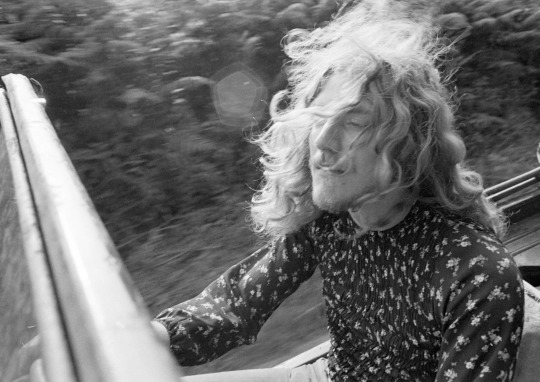
Robert Plant of Led Zeppelin driving at his home, Jennings Farm at Blakeshall in Worcestershire, England, circa September 1970. Photos by Mike Randolph.
#robert plant#led zeppelin#1970#70s#classic rock#mike randolph#with a beard like that he should be crowned king of england
837 notes
·
View notes
Text
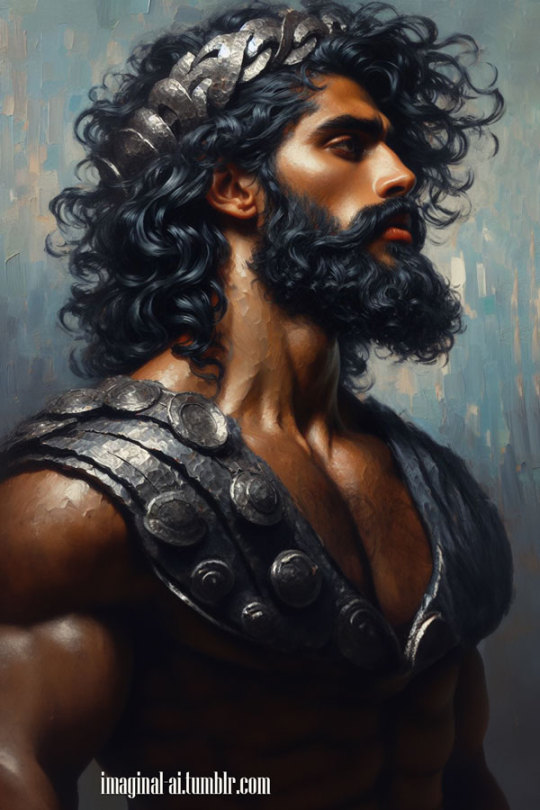
"Ahsan, the Just" (0001)
(The Ahsan Portrait Series)
#ai artwork#ai men#ai generated#ai art community#ai image#ai gay#gay ai art#longhairedguys#longhairmen#longhairedmen#long hair#royalty#nobility#arabian#muscular#ai art#art direction#crowns#guys with beards#bearded hunk#bearded man#handsome#gay fantasy#gay fantasy art#arab men#arab muscle#arab man
63 notes
·
View notes
Photo
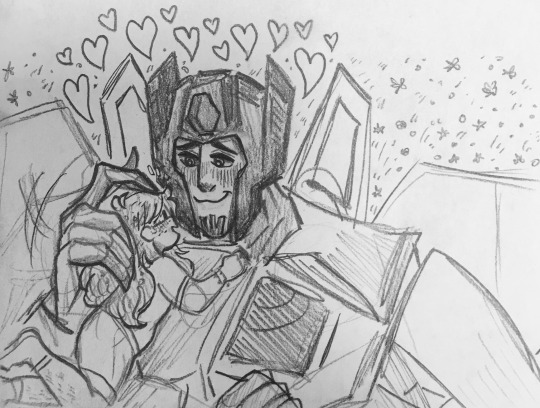
♫♪ what did i do to deserve you? ♡
☆ ̗̀ drawn in November 2022 ̖́☆
#hopelessly devoted motherfucker#i gotta adjust to drawing his nose. and his big cat ears#i will love every single version of him#self insert#self shipping#tf es#earthspark starscream#earthspark#starscream#earthspark starscream tag TBA#my art#maccadam#lil doodles#so many ppl were like 'his beard is stupid' DONT WORRY. I WILL LOVE IT *FOR* YOU PEOPLE#IT'S SHAPED LIKE A CROWN BECAUSE HE'S A KING!!! HE IS MY KING!!!!#I LOVE HIS FORM EVEN THO IT'S SO DIFFICULT TO DRAW THE HELM. WHAT IS THAT#dont worry babygirl bumblebee's helm is hard to draw too. its not ur fault... u were designed this way
152 notes
·
View notes
Text



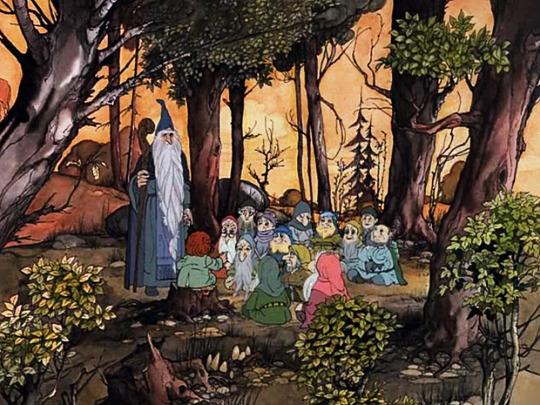
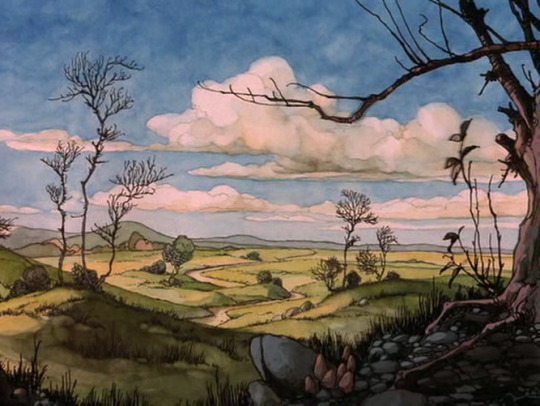

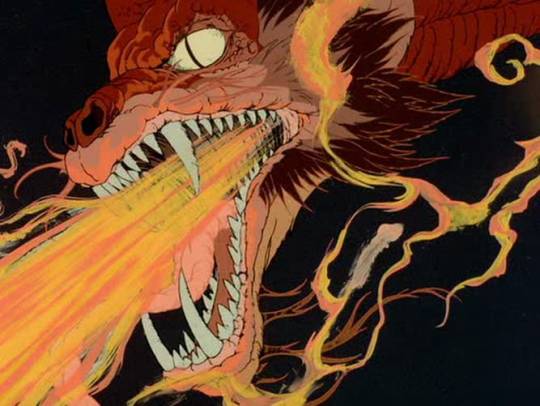
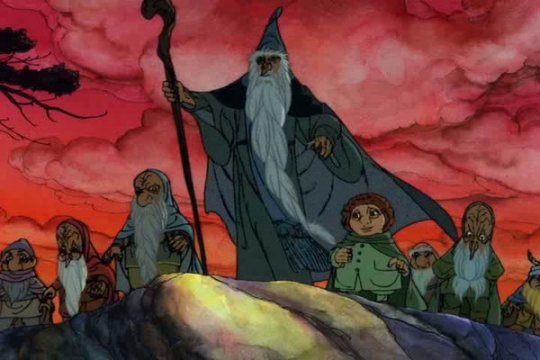

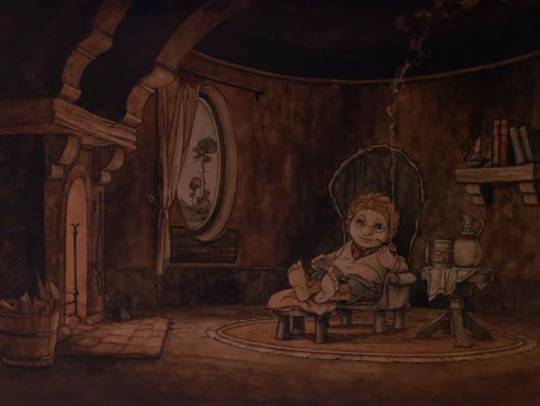
Despite its flaws, there has never been a more beautiful and faithful adaptation of Tolkien's work
#the hobbit#lotr#the hobbit 1977#rankin-bass#the sheer fact that they incorporated THE SONGS#the joy and relief of arriving at rivendell to a chorus of elfsong is unparalelled#and bearded elrond with a crown of stars is GOAT#i love the idea of him retaining a beard as half elven#....though in all honesty i think having become spiritually full elf his physiology wouldve followed suit#as the elven form is defined by a half spiritual body... his physiology would've had to have changed alongside his spirit#aragorn retained a strong spiritual form as well due to his elven blood... but as man did not have the full simulatenous conscious presence#and tolkien’s theology certainly wasnt dualist despite depiction of tangible spirituality... it was more ’multidimensional’ than individual#so i think elrond's material form must've aligned to elven biology as well to posess such a spiritual nature... meaning no beard :(#but we can dream cant we#at least we got the shipwright and the ancient un-fallen elves in the West probably have beards too#they'll give elrond one when he gets there
96 notes
·
View notes
Text
every fanart I see of Older!Arthur on my dash heals my soul you don’t understand
#to see Arthur’s whiskered face#beard smudged with grey and laugh lines crowning his forehead#:)#usually pictured with an arm slung around Merlin’s shoulders#the two of them falling into their usual bickering#the narrative begins again#except this time it’s well worn and well loved#<3#bbc merlin#arthur pendragon#NEED to see all of it please and thank you 💗🥺#will cherish it with my life
134 notes
·
View notes
Text
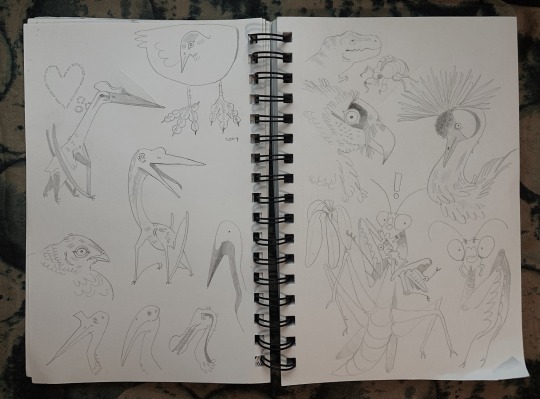

been using my sketchbook more lately 🐓
#my art#bird art#pterosaurs#praying mantis#paleo art#nature illustration#<- who let quetzalcoatlus be so big. who cleared that.#some birds featured here:#american coot#bearded vulture#grey crowned crane#something vaguely cormorant shaped#red junglefowl#marabou stork#snowy egret#blue footed booby#blue heron#ringneck dove#mantis tag
407 notes
·
View notes
Text
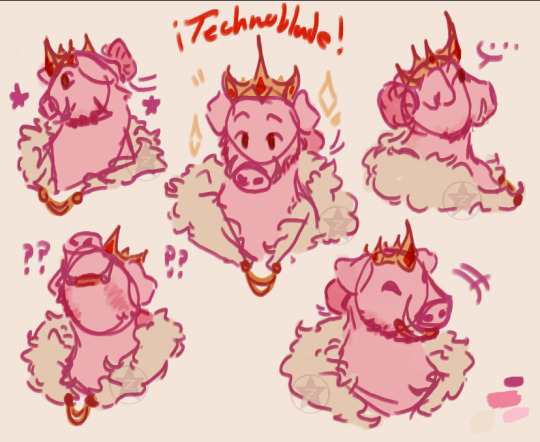
oddly enough, drawing technoblade to get me out of art-block hasnt failed me even after years of using this trick, but if i think abt that fact too much i'll cry so. hands u Him,
#technoblade#my drawings#zach creates#also little headcanon- ctechno has two crows. his formal crown (the big one) and his casual crown (the exact same one but tiny)#funny little thing before i cry again thinking abt him#also inspired by technodad's christmas video on techno's channel (he had a very nice beard ngl)
156 notes
·
View notes
Photo
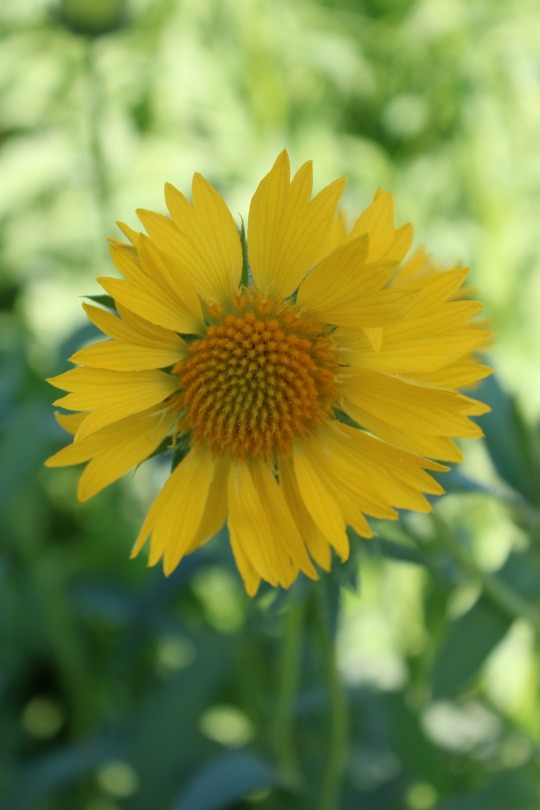
Golden Crownbeard (Verbesina Encelloides)
Toulouse, France
#photographers on tumblr#nature#flowers#yellow#floral#summer#flores#amarillo#verano#golden crownbeard#verbesina encelloides#gold weed#wild sunflower#vertical#original photographers#original photography#cowpen daisy#butter daisy#crown beard#american dogweed#south african daisy
168 notes
·
View notes
Text
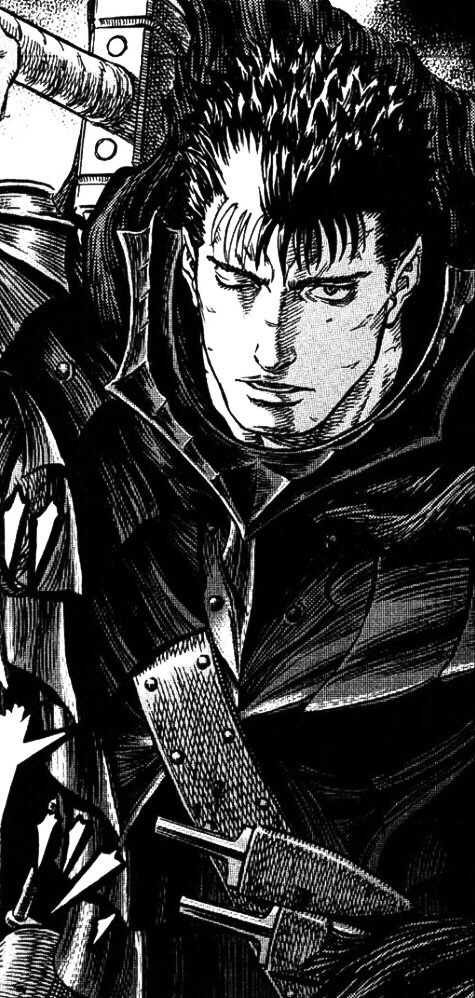
This man is 24 years old... he should've been at the club
#this is why he gets the sufferer crown i guess lol#i mean he HAS been thru it a few dozen times#i swear he looks like he's at least 35 tho#actually nah he'd need to grow a beard first#wouldn't be opposed to a moustachio'd guts at some point either#like does he shave with the dragonslayer or what#berserk#p
12 notes
·
View notes
Text
@bg-brainrot made Peepaw Gale in their fic set way after the defeat of the brain and so I had to make him!
Also read the fic, it's my favourite post game one!
#there was a longer beard but it looked fake#sorry this is my evil playthrough so he wants the crown#peepaw gale#mods
10 notes
·
View notes
Note
Mc: I would stop grabbing your beard if you made smart decisions!
Irus: *Gasp* I make great decisions!!
Mc: your last “great decision” was that beard.
Irus:…..*mumbles* My beard is great…
Poor Irus 🤣 he'd likely shave it off in secret and pitch up all smooth faced like he never had a beard in the first place.
60 notes
·
View notes
Text
Andrastian Statues
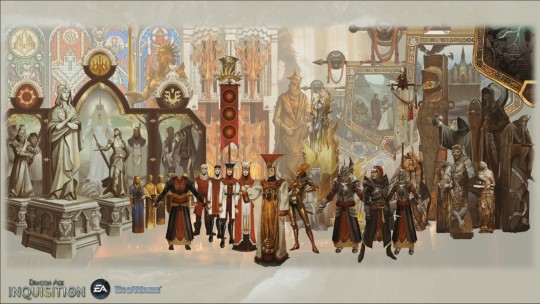
The purpose of this collection of statues is to show the Andrastian style depending on the region, the details in it, and how this may or may not influence other statues we saw in game. I also attempt to recollect some interpretations of them, although most of them are mostly based on speculations.
The current post contains the following set of statues:
Ferelden Style: Pre-Divine Andraste, Chasind Andraste, Ferelden warrior protector Andraste, The Maker, The Dwarf [?], Rider Maferath [?], Masferath Repentant, Hanged Masferath, Other Statues.
Orlesian Style: Rustic Maferath, Hessarian, Andraste; The Orlesian Warrior Andraste, The Stylised Orlesian Andraste, The Orlesian Andraste, The Orlesian Maferath, The Orlesian Havard, and the Orlesian Hessarian; The Weight of War
Free Marches Style: The Free Marches Hessarian, The Free Marches Andrastian Warriors [?]
Unknown Style: The Skull with sword, The Guide, Guardians of the Path / The Watcher.
[This post belongs to the series “Analysis and speculation of Statues”]
Ferelden Style
Pre-Divine Andraste
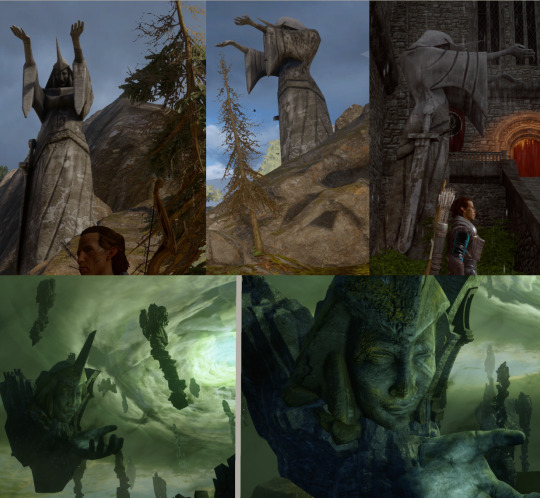
One of the most iconic statues in DAI.
It’s present all over Ferelden, specially in big, colossal statues along the paths of Hinterlands. They are so big that sometimes one can overlook them unless you look upwards [check Hinterlands: Statues, paintings, and structures found in the open].
In Skyhold, we can find this statue in a small version in the local chapel, which triggers the note Bride of the Maker.
Thanks to the DLC Jaws of Hakkon [Main Chamber of Razikale’s Reach], we know that this statue belongs to a pre-divine time. It is probably one of the oldest representations of Andraste we have in-game.
As usual, she has a one-spike helm that has strong resemblances to Flemeth’s tiara, and to Humanoid Mythal statue, Dragon Mythal statue, and the Ferelden Wyvern.
She has a sword in her hip.
Her sleeves and skirt have long lines that emulate folding. It’s a style we saw in statues that were considered “elvhen” in-game [for example, the Elven Archers or The guide]. But we can see this became an Andrastian style since we also see it in the Blocky bearded humanoid.
Her gigantic hands have been used in several elvhen places, and I wonder how meaningful these are: these hands appear in Exalted Plains: the Dead Hand as well as in the Shattered Library, holding eluvians. Is this a mere reuse of resources or hides some lore in it? We know DAI is less lazy about this than previous games.
This statue is curiously aligned with Humanoid Mythal statue in the Fade, as well as with the Imperial Highway Columns [check The Raw Fade: Part 1]. A Design choice that keeps me wondering if it hides some meaning in it.
Chasind Andraste
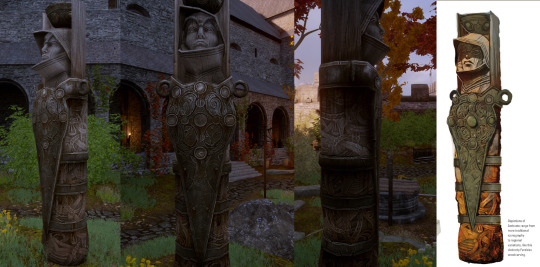
It has the design of a totem.
Its relief is very intricate.
She is represented as a protector warrior due to the strong presence of the shield on it.
We can suspect this statue is also ancient, and you can see that it has similar style to the Alamarri Monolith with swirls we find all over Hinterlands.
If you pick the Chantry-related garden in Skyhold, this statue appears in it and the archivist Banon will mention details about it in The Women of All War. He claims it’s Chasind, not original from Skyhold, brought by Ferelden into the castle. He also suggest it’s a re-usage of an ancient totemic statue.
This last comment streghtens the idea that ancient Andrastian art tends to be done over or using/co-opting statues from previous civilisations.
Ferelden warrior protector Andraste
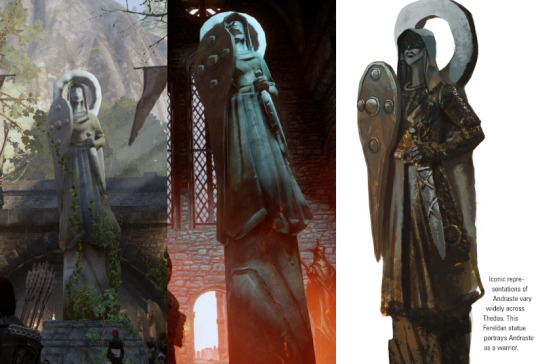
Another classic representation of Andraste in game.
It’s Ferelden style.
She is represented as a warrior [holding shield and sword] but also as a divine entity [I suspect the ring behind her works as a rustic design of a halo].
There is a chance that the thick “halo” could be an adaptation from another icon we saw among the Elvhenan design: the Golden Ring. How is this possible? I think it’s not too strange considering how deeply related to the elves the Avvar are. If we think that part of this culture comes from the Alamarri, one could guess that through the elvhen lover that Thrydda had, some elvhen presence has been around this culture to incorporate elvhen iconography in their own art, translated later into something of this shape.
The Maker
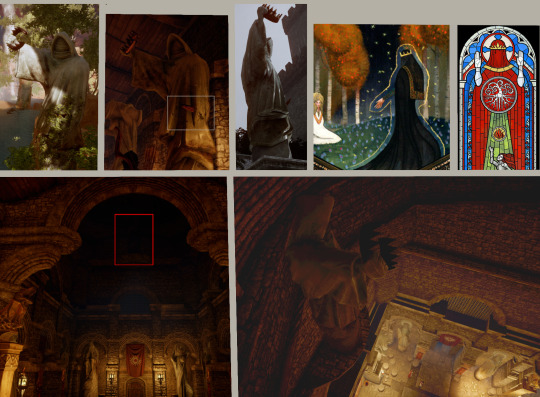
This mysterious figure has no face, in fact, it looks like bandaged. In his right hand holds a crown, while in his left hand, a dagger. The outfit is a very simple robe.
The dagger is quite curious for a representation of the Maker.
This statue took me a long whlie to identify. In early posts I kept calling it Faceless figure holding a crown. I came to the conclusion it is the Maker.
This statue appears always within the context of the Andrastian statues, so it could not be asumed in any other way than related to the Andraste Myth. In the posts Andrastian Design: Stained Glasses and Andrastian Design: Tapestry and Tryptich, we can see that a figure with no face and wearing a crown of similar characteristics is represented as the Maker. These are my main arguments to be confident about this identification.
In Hinterlands, he appears in the main hall of Haven very high upon the hall, hidden in the shadows, in a room filled with andrastian iconography, which reinforces the idea that it represents an entity that is above all of them, Andraste included. Another confirmation of being the Maker.
It also appears in the Tyrdda Bright-Axe Path, which has a mixture of statues, and in Forbidden Oasis, when the place was took by the Andrastian forces. It also appears in the mysterious Hinterlands: The Unknown Ruin. Other more natural and Andraste-related places where we find it: Redcliffe - Future, Therinfal Redoubt, Western Approach: Adamant Fortress.
The Dwarf [?]

This figure was tag along the blog as Blocky bearded humanoid. It is found in the main hall of the Templar building of Therinfal Redoubt and in the corridors of Redcliffe - Future
The design of this statue feels closer to the pre-divine Andraste. Maybe it has some influence of the Alamarri style.
The long lines on sleeves and chest seem to suggest similarity in style with the pre-divine Andraste but also with the elvhenan statues such as the Elven Archers, or The guide.
Its face seems to show a big smile, but if you see it with more detail, it may also represent a long, long beard. The broad constitution, the big ears, the lack of hair, and the prominent beard seem to suggest a golem-like or dwarven representation.
I can’t say I can identify this figure in the Andrastian Myth, but it’s related to the Andrastian Faith since it appears where there are other andrastian figures.
If this figure comes from the Alamarri and it was co-opted by the Andrastian faith, I could suspect that may be related to the dwarven culture that Alamarri had. If we remember Tyrdda Bright-Axe Path, she had a child with a dwarven prince. The Chasind also had mixed descendants of humans and dwarves. So, if it’s an alamarri statue co-opted by the Chantry, it could not be strange for it to be a dwarf. These details may indicate that the Alamarri had a deeper relationship with not only elvhen, but also dwarves, and this aspect appeared in the art until co-opted by the andrastian faith resulting in this figure.
Rider Maferath [?]

This statue appears only in Fallow Mire. Although, the same statue appears riding a horse in Crestwood: surface. Maybe it’s a mere reuse of resources.
It has a similar design to the Blocky bearded humanoid.
It represents a man with a beard, and its angular design may suggest similar time and style than the previous one.
More details in the section Other Statues from this post.
Masferath Repentant

Mostly seen in the region of Ferelden [although, you can find it too in Western Approach: Adamant Fortress]
This is the typical Ferelden statue of Masferath, regretting his betrayal.
He is sitting on a stone which has a design of a snake surrounding it, representing the Tevinter influence or deal he made with the Archon before handing over his wife.
The helm in this statue has a C-shape, which I find very similar in design to the Tevinter helms [check section “Outfits” in Patterns and Styles: Tevinter]. I’m not sure if this is mere coincidence, or it speaks of a common [dragon-inspired] origin source.
Hanged Masferath
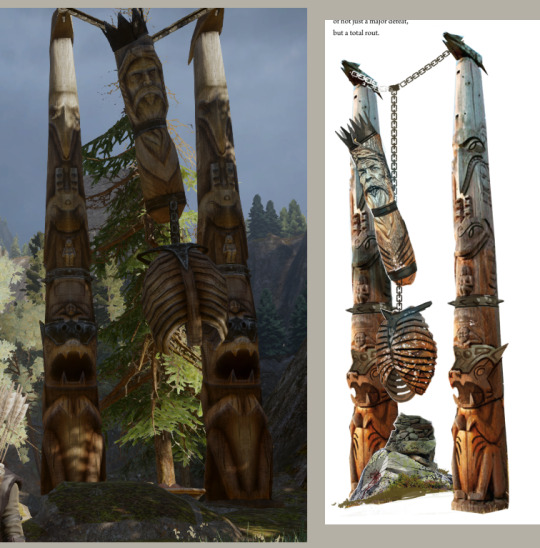
This totemic sculpture can be found in Hinterlands: Statues, paintings, and structures found in the open.
This is a Ferelden representation of Masferath being hanged. Clearly Ferelden has a strong sentiment with his betrayal.
The totemic structure seems to show mabaris at its base, followed by two different kinds of birds or maybe it’s a dragon [hard to say].
The top of these totems keeps bringing my attention: I can’t stop thinking there may be some link with the Tevinter metallic statue that I called “Tevinter bird”, found in Ferelden in the underground region of Crestwood: Flooded Caves.
Other Statues
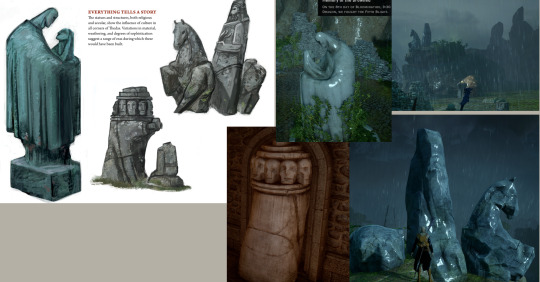
The couple can be found in Hinterlands: Redcliffe - Present, as a symbol to remember those who died in DAO-Redcliffe. It can also be found in Crestwood: surface as a memory statue of the drown, and in Frostback Basin [DLC]: Nigel’s point, as a memory statue of Ameridan’s friends: The templar Haron and the dwarf Orinna. It feels more like a reuse in most cases since it’s a strange statue to represent "fallen/lost people”. Certainly we can assume it’s Ferelden made.
The horse with the rider seems to have, as we see in its drawing from the book Art of Inquisition, a lot in common with the previous statue I called “Rider Masferath”. The horse has been removed in some other places to only let the human figure stay. It can be seen in Fallow Mire without his horse, and in Crestwood: surface. Sometimes the rider is not well chiselled in the stone.
The vessel with many faces is only seen once in the game, in the The Darvaarad - Part2. We know the Qunari took this castle and put a lot of statues that they gathered around the world. However, this statue of many faces looks like it belonged to the inner corridors of the castle, implying the castle per ser may have been Ferelden, or elvhen in origin, but repurposed by Ferelden later. In the game we only see the “back” part of it, while in the book Art of Inquisition, we can see the full statue, which implies a beheaded figure. Maybe it’s the representation of a jury. It could also be interpreted as an entity that puts “the right head” into the people, suiting the Qunari and their Qun philosophy, but this interpretation would make me question why it is so related to Ferelden art in the Art Book.
Orlesian Style
Rustic Maferath, Hessarian, Andraste
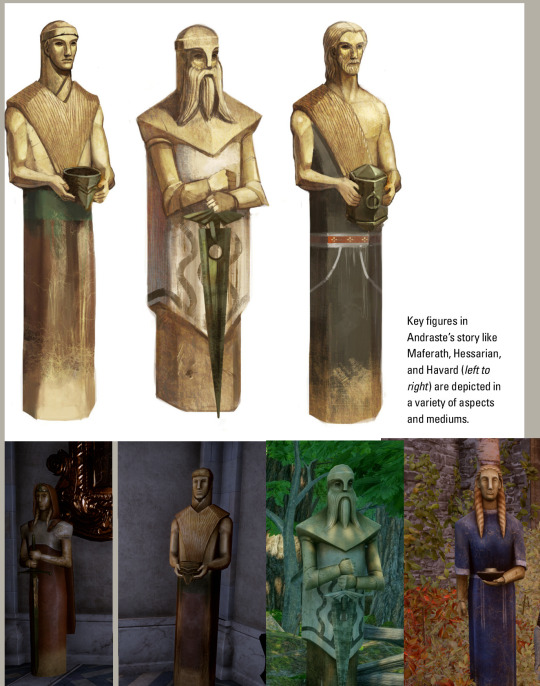
A bit distant to the style of the Blocky bearded humanoid, we have these series of statues representing typical characters from the Andrastian Myth.
They are mostly located in different areas all over Orlais [or inside the Skyhold if you pick an Andrastian garden].
We find Andraste, in blue and red [I’m assuming one is the bride of the Maker, while the other is the warrior protector of her people]
Masferath is carrying a crown (?) in his hands, and Hessarian is holding the Sword of Mercy.
These seem to belong to an Orlesian style but rustic or more “popular”. They give me the impression that were made by the working class people who could not afford realistic artists to sculpt them in stone.
They seem to be made out of wood.
The Orlesian Warrior Andraste

Unlike the previous one, this Orlesian statue is made out of stone and is bigger, more detailed, and realistic. It seems to appear in rich/high class places.
It also appears in Emerald Graves: Din'an Hanin, which may represent the influence of the Andrastian faith among the Ancient Dalish when the Dales was their Kingdom land granted by Andraste herself.
This statue presents Andraste as a warrior: she is wearing a detailed armour, a big sword, and, curiously, a helm that has no iconic single-spike. However, I can see some similarities in the armour design to Flemeth’s armour or the armour used by Humanoid Mythal statue.
Due to the strong similarities in style, this statue belongs to the same group than the Orlesian Andraste, Orlesian Maferath, Orlesian Havard, and Orlesian Hessarian.
The Stylised Orlesian Andraste

Another over-detailed statue of Andraste made out of Stone which appears in wealthy places.
The whole design of Andraste has a strong similarity to Tyrdda Bright-Axe, which may suggest that this statue may have a strong alamarri influence, mixing Andraste tale with the representation of Tyrdda.
The icon that represents the sun, ironically, has a strong similarity with the statue I called Sun-head creature, deeply related to the Elvhenan and, potentially, to Tevinter and its old dragon gods. This may imply that this statue may have collected several icons and details from different cultures and faiths to gather them in the cult to Andraste. This process is well known in human History, where the forced religion tries to blend with the local ancient one to produce an assimilation of the new faith.
The Orlesian Andraste
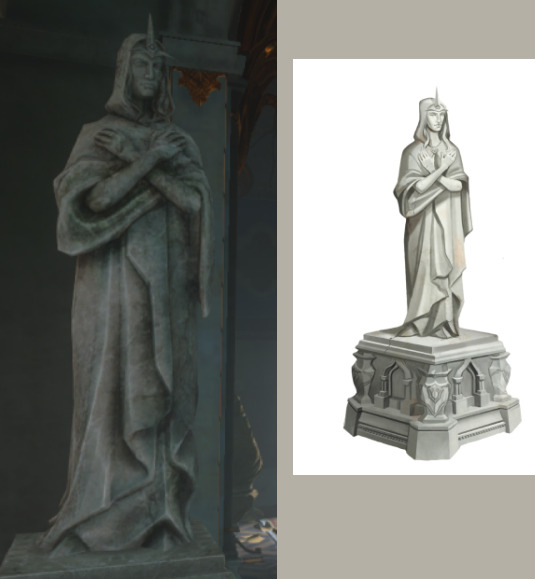
This Orlesian statue is made out of stone and is bigger and a lot more detailed and realistic that the “wooden” sculptures.
It tends to appear in wealthy places as well as inside the Chantries of the game.
It represents mostly the divine Andraste and the bride of the Maker, without any element of her warrior side.
She has a one-spike helm that has strong resemblances to Flemeth’s tiara, Humanoid Mythal statue, Dragon Mythal statue, and the Ferelden Wyvern.
Due to the strong similarities in style, this statue belongs to the same group than the Orlesian Warrior Andraste, Orlesian Maferath, Orlesian Havard, and Orlesian Hessarian.
The Orlesian Masferath
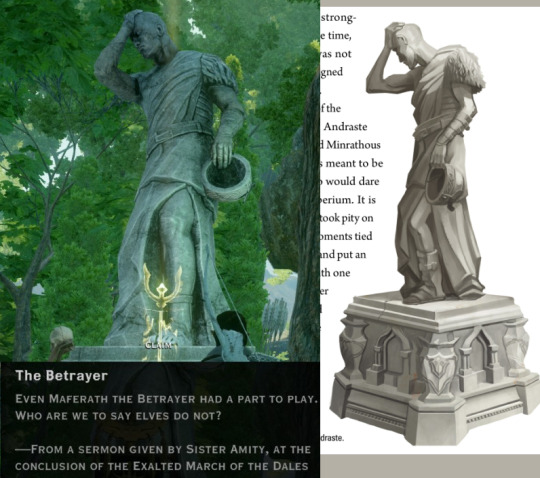
It is called “The Betrayer”.
We see the man worried, grabbing his own head, showing the weight of his own betrayal. He keeps the crowd of his leadership of the Alamarri in his hand since the Chantry tale says that he betrayed Andraste out of jealousy because she was more important than him among their people. I always questioned this since he was the one commanding the armies and their people into Tevinter, and he may have chosen the “lesser bad” option [read the The Chantry and the Mythology of the Chant of Light for more details].
Due to the strong similarities in style, this statue belongs to the same group than the Orlesian Warrior Andraste, Orlesian Andraste, Orlesian Havard, and Orlesian Hessarian.
The Orlesian Havard

Havard is shown here with avvar clothings [fur-based].
He is carrying the urn of Andraste’s ashes that will be placed in Haven and will become later the Temple of Andraste [DAO].
We know thanks to the notes triggered in it that this statue seems to represent Havard but its appearance was based on a noble’s lover [check it in Emprise du Lion: Pools of the Sun].
Due to the strong similarities in style, this statue belongs to the same group than the Orlesian Warrior Andraste, Orlesian Andraste, Orlesian Maferath, and Orlesian Hessarian.
The Orlesian Hessarian

He is holding the sword that will be called the Sword of Mercy, used to kill Andraste in the pyre so she could not suffer anymore.
His hat has a bent T-shape that we can see in many other helms of Tevinter warriors in the section of “outfits” in Patterns and Styles: Tevinter.
Due to the strong similarities in style, this statue belongs to the same group than the Orlesian Warrior Andraste, Orlesian Andraste, Orlesian Maferath, and Orlesian Havard.
The Weight of War

This statue was tagged in this blog as Man holding bigger head for a long while.
It has appeared in Forbidden Oasis, Redcliffe - Future, and in Orlais: Winter Palace.
Thanks to the constant presence of Andrastian-themed art around it, I could finally assume that this statue belongs to Andrastian art in Orlesian style.
The main man has angular features, his ears are not visible since it looks like he is wearing a chain-mail. He uses scale-based pauldrons, and a robe. He is holding a sword with one hand while the other holds a bigger head. By comparison with the state of the overall figure, we can assume that the bigger head has a lot of wounds and scars [meaning that this is part of the sculpture design and not a consequence of erosion].
Despite looking similar, the head in his hand and this man’s profile are different. The bigger head has a smaller, shrank nose.
The only significant shape in this statue that can give us a resemblance of a hint to whom it belongs is his belt, which has pointy ends. We had seen this pattern in two places: in Tevinter artefacts, such as the sacrificial burial, or in andrastian outfits.
It triggers a codex called The Weight of War which is a bit unreliable, since the person explaining this is an amateur historian, but it’s the only hint we have about this statue. The amateur historian implies that this statue may belong to a warrior with a philosophy similar to the Grey Wardens.
More details about this statue in the post Forbidden Oasis.
Free Marches Style
The Free Marches Hessarian
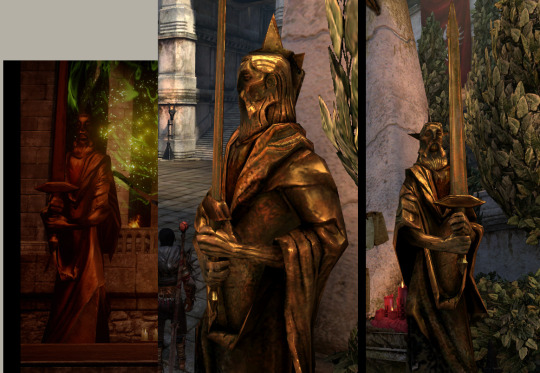
It appears mostly in the Templar fortress of Therinfal Redoubt
This statue has a strong resemblance to Tevinter art. It’s not only the dark metallic material used for the sculpture, which was strong similarities with Tevinter artefacts such as Thrummer, Water dispenser, Tevinter urn, Tevinter artefact with spikes, Tevinter golem or Claw of Dumat, but also the prominence of angles and pointy ends.
There is no codex associated with this sculpture, but I can guess it may represent Hessarian [the main Tevinter figure in the Andrastian Myth] since this statue has a version carrying a sword.
It has a long beard and hair.
This statue has also been present in DA2, specially in the Chantry district of Kirkwall [check it in Architecture of Kirkwall : The Chantry].
The Free Marches Andrastian Warriors [?]

It appears mostly in the Templar fortress of Therinfal Redoubt and in the Fade.
This statue has a strong resemblance to Tevinter art. It’s not only the dark metallic material used for the sculpture, which was strong similarities with Tevinter artefacts such as Thrummer, Water dispenser, Tevinter urn, Tevinter artefact with spikes, Tevinter golem or Claw of Dumat, but also the prominence of angles and pointy ends.
It’s wearing a typical DA2 Andrastian robe, but the helm has always brought my attention: it has a lot of more similarity to the Tevinter warriors than to the one-single spike helm of Andraste.
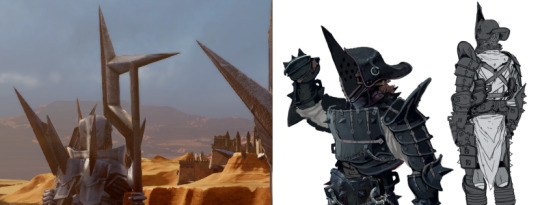
Its weapon also has a strong similarity to the weapon used by Tevinter golems, while its helm has strong similarities with the ones that belong to the Tevinter warriors. One may say that both of them, in fact, are representing the one-spike helm of Andraste.
The unmistakable identification with Andrastian faith is given by the robe: if we see the chest, we will see the pointy half sun on it, which was the main design of the outfit of Elthina and other chantry priests we saw in DA2.
Unknown Style
The Skull with sword
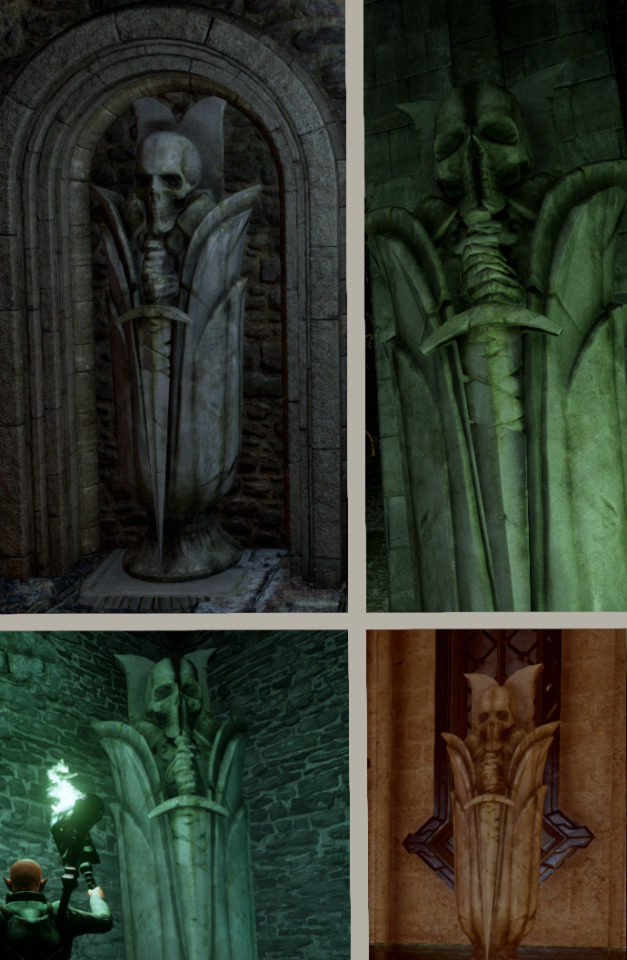
This is the statue that I called Skull bud with sword all over this blog.
The skull is quite long for a regular human. It holds a sword. The body seem to be inside a bud or a shell that may look like a flower bud but also as the shell of an insect/scarab.
This statue has always appeared within Andrastian contexts such as in Frostback Mountains - Haven [the basement], Hinterlands:Dead Ram Grove, or Ferelden: Therinfal Redoubt, but also in places where the Andrastian context is not that strong, but still yet reasonable to appear, for example in Hinterlands: The Unknown Ruin [overtaken by Andrastian faith lately, so far we see in the statues present in this room], or Emerald Graves: Din'an Hanin [which clearly shows how the Ancient Dalish allowed a certain level of assimilation of the Andrastian faith thanks to Andraste’s gift of the Dales]. However, we also find this statue in Western Approach: The Still Ruins, Viridis Walk and Inner Sanctum, which is a pre-blight Tevinter building, so one is inclined to think that this statue may have been Tevinter in origin, and somehow, adopted later by the Andrastian faith. Or maybe it’s just Elvhenan, taken first by Tevinter, and later by the Chantry [as we see this pattern repeats over and over with everything related to Tevinter].
One of the potential interpretations is that this sculpture represents a coffin, or a dead who is put to sleep in this position. The fact that this skull is inside a bud or an insect shell [in addition to the speculation that, like all what comes from Tevinter, was originally elvhenan] brings the possibility of being related to Uthenera and the mysterious codex of Vir Dirthara: A Flowering Imago that I tried to multi-interpret in several ways in Ancient Elven codices; Vir Dirthara.
So far I know, there is no codex associated with it, and we have only speculations about it.
Its style is not strongly similar to all these Andrastian statues, but the fact that it appears mostly within andrastian themed rooms, it’s hard not to bring it into this post.
However, I’m not confident about how to understand this statue and to what culture associated it with.
The Guide


It can be seen in three places only: Emerald Graves: The open pointing more or less towards Elgar’nan’s Bastion, on top of Stone-Bear Hold Avvars - Part 2 pointing out to the sea, and in the Fade, exactly in Flemeth’s Fade: Part 2, pointing the path towards Mythal/Flemeth.
It’s associated with the unreliable landmark called The guide [written by this orlesian scholar who lacks of deep knowledge of elven culture], which identifies it as an elvhen statue, but it has a lot of style similarities to the Blocky bearded humanoid and the pre-divine Andraste as well as to the Skull bud with sword. If we see the back of an Elven Archer statue, we can find line-based similarities too, so it’s hard to decide whether this is truly Elvhen in origin and co-opted by the Andrastian and repurposed later, or it truly belongs to the set of pre-divine statues we spoke above and this amateur scholar misunderstood it as Elvhenan.
The unreliable landmark links it to Falon’Din for the mere fact that it is pointing out a place, so it “guides”. If we overlook this pathetic logic, and we give it a remote chance for it to be elvhen, we should be careful to identify it with Falon’Din. First, Via Solas, we know that Falon’Din was far from guiding people [Check Evanuris], and second, even if we consider this statue to be Falon’Din, we should never forget how Falon’Din and Dirthamen are entangled one another [check Humanoid Dirthamen], so this could also be a statue representing Dirthamen. The shape of the sleeves has some resemblance to the Elven Owl statue [they have long lines along it], but once more, both gods are so indistinguishable one another that it’s hard to say who is who.
Guardians of the Path / The Watcher

This hooded statue was called Humanoid Dirthamen/Falon'Din in this blog.
The hooded statue can be seen in four places: in Emerald Graves: The open, as a watcher of entrances, in the Hinterlands, along the Tyrdda Bright-Axe Path inside the Calenhad’s Foothold; in Exalted Plains: Northern Ramparts and Citadelle du Corbeau, as the main big statue when you step into the Citadelle [again, watching over an entrance] and in Flemeth’s Fade – Part 2, as a statue bleeding profusely with a sword in its back, as an unmistakable symbol of betrayal.

In all these cases, the hooded version of the statue seems to be related to “watch or protect entrances”. Due to its presence in the Fade of Flemeth, we also can associate it with deep betrayal.
Once we see how the pattern unfolds with the statue I called Humanoid Dirthamen/Falon'Din [hodded version] we can understand the Andrastian version “guardian of the path” in similar fashion [he always appears in entrances as well], suspecting it was a re-usage and co-opt of the elvhen hooded statue when the Andrastian forces conquered the Ancient Dalish's lands.

The Guardian of the Path appears twice in game: in Crestwood: surface, at the entrance of the region, similar position as the hooded versions in Emerald Graves, and in the entrance to the region of the Exalted Plains.
#andrastian design#andraste#The Guide#guardian of the path#Skull bud with sword#Man holding bigger head#orlesian design#ferelden design#Humanoid Dirthamen/Falon'Din#andraste statue#hessarian#havard#Maferath#blocky bearded humanoid#Faceless figure holding a crown#the maker#maker#Analysis and speculation of Statues
15 notes
·
View notes
Photo

If I remember right Lapin became the SPF’s warlock when he was a teenager, I picture him as a young adult full of angst and rage at the world.
#Lapin Cadbury#Lapin my Beloved#Crown of Candy#dimension 20 fantasy high#dimension 20#Lapin Cadbury Fanart#ive been trying to draw him for so long#all i had to do was make him young and not have a beard#Crown of Candy Fanart#digital art#fanart#CoC#d20 a crown of candy#d20 CoC
235 notes
·
View notes